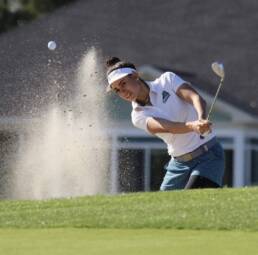g o l f
College golf is very popular in the United States, where there are more than 1,000 colleges with men’s and women’s golf teams. In the best universities, it is not uncommon to find players who are in the top 500 of the WAGR (World Amateur Golf Ranking). The structures are very professional, with renowned coaches, physiotherapists, physical and mental trainers, and many other advantages available to athletes. However, it is important to know that not all universities are comparable in terms of golf infrastructure and facilities. This will not prevent students from enjoying their studies, while being able to practice golf daily with their teammates, and travel to regional or national competitions to represent their university.

Choosing between golf and studies?
At most universities, it is possible to combine golf and studies effectively. However, there will always be some universities that are rated higher academically and others that are better known for their golf facilities and high level of competition. Before making your final choice, it is essential to determine which is more important to you, the athletic and the academic.
The level of scholarship eligibility and the geographical area can of course also be determining factors in your final choice. Some players will aim to go professional after their university education. In this case, it will be important to find a university that has a very competitive golf team and plays in a strong league. Other players may want to use their golf skills to get into a university with a strong academic reputation, such as Harvard, Yale, or Princeton. Other universities such as Stanford, Duke, or UCLA are also highly regarded, both academically and athletically, but the budget will also be higher and it will be more difficult to meet the admission requirements. Families who cannot afford to spend a lot of money on their child will prefer universities with large scholarships, while families with a larger budget may want to consider a university with a higher golf and/or academic reputation.
The golf season
Golf is a year-round sport in college, but the official NCAA/NAIA season is in the spring, which is called the “spring season”.
- Fall Season: August-December (4-6 tournaments)
- Spring Season: January-May (4-6 tournaments, conference tournament, national tournament if team OR player qualifies individually in the conference tournament)

NCAA vidéos
Click here to watch videos of the National University Championship Finals in Division I, Division II and Division III:
Trainings and players
- Between 20 – 30 hours of golf per week
- Practice sessions that can last from 2 to 4 hours
- 3 physical training sessions per week on average
- Between 5 and 12 players per team with only the top 5 going on to tournaments
- 18 hole qualifier at practice to determine who will make the top 5
- Never more than 1-2 weeks rest between tournaments
- The coach chooses his top 5 based on the attitude and performance of the players in practice, in qualifying holes, in official tournaments, but also on their attitude off the golf course, their academic results, and other criteria.

Ranking to be accepted in a DI, DII, DIII or NAIA
These questions will be answered during our free initial consultation and after reviewing your online application.
A typical day for a golf player
- 7am: Breakfast
- 7:30am – 8:30pm: Fitness
- 9am – 12:30pm: University course
- 12:45 – 1:45: Lunch and rest
- 14h00 – 17h: Golf training with the team
- 5:30 – 6:00 pm: Care
- 6:30 pm: Dinner
- 20:00 – 21:30: Study/Homework

Former and current professional golfers who have played for a university in the US while pursuing a university education:
- Tiger Woods – Stanford University
- Dustin Johnson – Coastal Carolina University
- Collin Morikawa – University of California
- Justin Thomas – University of Alabama
- Xander Schauffele – Long Beach State and San Diego State
- Scottie Scheffler – University of Texas
- Paul Casey – Arizona State University
- Matt Fitzpatrick – Northwestern University
- Brooks Koepka – Florida State
- Adam Scott – University of Nevada
- Rickie Fowler- Oklahoma State University
- Victor Hovland – Oklahoma State University
- Jon Rahm – Arizona State University
- Bryson DeChambeau – Southern Methodist University (SMU)
- Ingrid Lindblad – Louisiana State University
- Rachel Heck – Stanford University
- Annika Sцrenstam – University of Arizona
- Natalie Gulbis – University of Arizona
- Danielle Kang – Pepperdine University
- Michelle Wie- Stanford University
- Maria Fassi- University of Arkansas
- Rose Zhang – Stanford University

